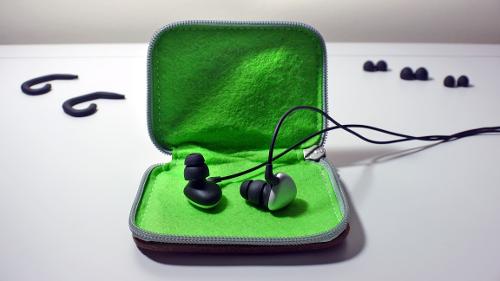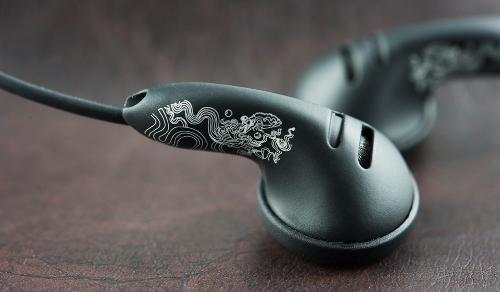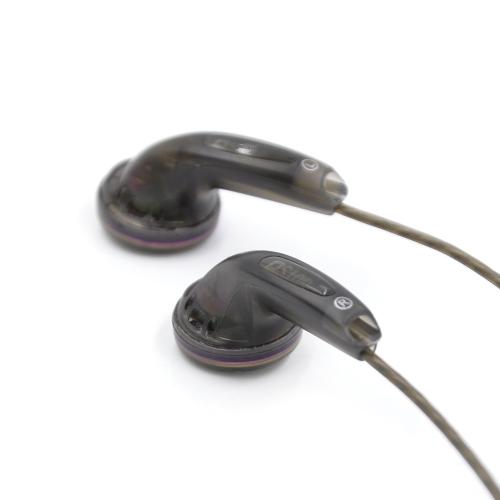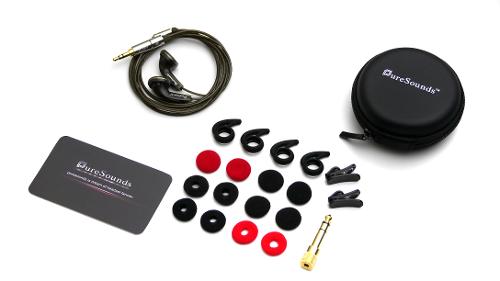--
My review of the
PMV A-01 Hybrid IEM:
 -All photography taken by me-
**Disclaimer – The A-01 was shared with me by PMV, with the Help of PenonAudio**
[Product Link
-All photography taken by me-
**Disclaimer – The A-01 was shared with me by PMV, with the Help of PenonAudio**
[Product Link]:
http://penonaudio.com/Earphones/In-ear-earphone/PMV-A-01
 *Specifications*
*Specifications*
Drivers: 10MM Dynamic + Dual Armature Drivers
Cable material: silver-plated OFC
Cable length: 1.3m
Plug Type: 3.5mm gold plated
Speaker Impedance: 13Ω
Sensitivity: 110 ± 3dB
Distortion: <3% (1KHZ, 1mW)
Frequency range: 20-20000HZ
Maximum power: 10Mw
 *Packaging *
*Packaging *
PMV went with a simple box for packaging, with basic black on the front and a prettier blue back cover with its colorful hue: Business in the front, party in the back. Inside you will find the A-01 and its accessories sitting comfortable in a layer of cut out foam.

 *Contents*
*Contents*
PMV A-01 In-Ear Earphone
3 pairs of Silicone Eartips(S/M/L)
One pair Double-Flange Eartips
One pair Earhook
Carrying Case
Again, there is simplicity to the accessories. You get standard silicone eartips in multiple sizes along with one pair of double-flanged. I guess if I feel like being picky, it would be nice to include some foam tips, but I just used a pair of Comply T500 I had laying around. The ear hooks are also of a normal design that is found along with other earphones and are built well enough along with working like they should.
The Carrying Case however, does stand out as the light brown material is felt like in both appearance and feel. Inside the case your eyes are greeted by a powerfully bright, neon green cushioning. Not sure if my pictures will do justice of just how intense the color is.

 *Build/Design*
*Build/Design*
Quoting the product description: “Earphones’ back cover after high precision CNC process, sandblasting, anode and other technology enhanced the texture of the earphone”. It all adds up to the A-01 having quite the fancy housing. The only, small issue is that the L and R labeling is small and a bit hard to read.
From the Y splitter down to the 3.5mm plug, you will find that the cable is thickly braided with a Kevlar bulletproof silk fiber. So if you get in a gun fight, you have some added protection. From the Y splitter up, the cable is your standard rubber cover, which allows for more flexibility. Strain relief more than sufficient throughout.
There is no microphone option, for an earphone that can easily be driven by a cell phone, it would be a nice feature to include.
The PMV A-01 is a very solid built from end to end. It also looks quite good as well, subtle, but premium at the same time.

 *Fit/Comfort*
*Fit/Comfort*
The A-01 has a relatively small housing that is well shaped for the inside of your ear. Also, the nozzle is rather short, so it does not intrude inside the ear much. Both of these feature help the PMV Hybrid to be worn with ease.
The PMV A-01 can be worn in a few different ways and they are all super comfortable:
Cable Down – While the A-01 was designed as around the ear fit, they can be worn straight down as well. I found this to be surprisingly comfortable, though I am sure it has a lot to do with the smaller, very smooth housing. I touch of microphonics can be heard with this fit.
Cable Over the Ears – Worn this way you more comfortable fit, with the elimination of any microphonics. While the cable is flexible, it is a bit springy and light which in return does not help to stay perfect in place around the ears.
Cable Over the Ear with Guides – Here we have the most preferred and effective way to wear these PMV Hybrid earphones. The A-01 stays firmly in place with a quiet cable. Comfort is at the highest level and little ear fatigue to speak of with extended use.
 *Sound*
*Sound*
Lows – The PMV does it best to stay on a neutral level. As such, these are not too heavy in the bass department. While there a touch of sub-bass in the distance, it does well to stay controlled instead of powerful. The same goes for the mid-bass which is slightly subdued. The A-01 went for quality instead of quantity down low.
Mids – If there was any bias in the sound signature, one might find that there is the smallest, I mean really small boost of mids. While listening to “Adele – Hello”, her vocals were intimate and focused. The whole mid-range is silly smooth yet very much detailed.
Highs – That smoothness from the mids tricks to the highs, while not rolled off too early, they are in return never harsh or sibilant. It is this easiness to the upper frequencies which gives the A-01 an advantage of extended use to fight off sound fatigue
Tuning – PMV did a fantastic job finding a great overall tune for the A-01. It has a smooth balanced sound throughout the signature. The Dynamic and Dual Armature drivers all seamlessly work together to keep music flowing at a very high quality. The PMV A-01 due to its hybrid design was able to keep up with quick movement at speed with no delay.
Soundstage – I was caught a bit off guard by the decent distance the A-01 could provide. Not sure what is going on in those tiny triangle housings, but PMV was able to find a good amount of soundstage in a closed IEM.
Isolation – Due to the smaller housings and nozzle insertion depth, the A-01 does not have the best isolation. While I did not find there to be any sound leakage, I could still hear a little of what was going around me when I took my morning walks to work.
 *Comparisons*
*Comparisons*
Hybrids, they are everywhere, but who does them right?
PMV A-01 ($69) vs. Hoomia H8 ($96)
These two, really do not have much in common on paper or in actual testing. They even start off being price transposed of each other.
The H8 has a more pronounced presence in the lows, with ever so slight rescission in the mids. The A-01 is the exact opposite, with only a touch of bass and ever so slight bump in the mids. Ok, so I lied a bit, I after comparing the two side by side, treble response for both IEMs is closer than I remembered. Both seem to deal with the upper range with care and clarity. Sound isolation is night and day. The H8 blocks amazingly well, while I have already mentioned that it is not a strong suit for the A-01. The H8 has a bit of microphonics, while the A-01 does well to keep the cable quiet. Hoomia included a microphone, where PMV chose to forgo that feature. There really is no winner or loser here, more of a, what do you prefer or need in an earphone. Though, it must be factored in that the PMV has quite the value costing almost $30 less.
--------------------------------------------------------------------------------
PMV A-01 ($69) vs. Bette/i.VALUX 8MM 1+1 Hybrid ($50)
Down one Armature driver, the Bette/i.VALUX does its best to keep up with the PMV, battle of the budget hybrids.
Right away you will notice a slight V shaped signature in the Bette/i.VALUX IEM. The PMV on the other is flipped is more n shaped with its reproduction. Both earphones focus on music primarily and skip the microphone. Comfort will always be a personal thing, but while the Bette/i.VALUX is your typical earphone shape, it just cannot match the smoothness of the PMV. Build wise, the A-01 has a big advantage from bottom to top. Not that the Bette/i.VALUX is built poorly, it is just that the materials and attention to detail are top notch for the PMV. The Bette/i.VALUX does hold the edge on isolation. Value wise, it is pretty even. The Bette/i.VALUX gives up a fancy build for a solid sound and lower price, while the PMV packs a premium punch in design and fit. Again, the winner here is the earphone that best suits your needs.
 *Overall Thoughts*
*Overall Thoughts*
The PMV A-01 produces a neutral bass response, which could be viewed as slightly bass light. Mids are something special and do very well to bring out the most of the Hybrid drivers. Highs while refreshingly smooth, also bring out a good amount of clarity.
Build quality is through the roof for a $70 earphone. PMV outdid themselves with both design and materials. The A-01 looks way above its price range.
Where I see a little room for improvement? Maybe adding a pair or two of foam tips so that the A-01 can be a little more versatile in its fit. Again, the Comply T500 fit great. Also, maybe release a microphone version, as I am sure this earphone will be used with a lot of cell phones and on the go.
Any little improvement I may suggest, are very small. On the whole, the PMV A-01 is an excellent Hybrid and an excellent value. So if you are looking for a high quality earphone, with a comfortable fit, an almost neutral signature and slightly subdued bass, then look no further.


--























































































































































































Congratulations on the nice review, and happy you also like the Dragon2+